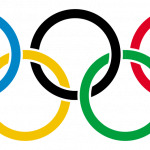By Hannah Anderson
Last week, Desiring God posted a piece by John Ensor that likened the complementarian model of marriage to the choreographed movements of a pair of figure skaters. Ensor writes:
Sochi is helping me be a better husband. And the Olympics are freshly making my wife to delight in her role as well. The surprising lesson is on display in figure skating pairs. At its best, this event displays the strength and beauty of unity: how two different people become one. The gold goes to that couple which has most mastered the skill of male leadership and female support, making one glorious whole.
Ensor’s use of this metaphor is not unprecedented. Author and teacher Mary Kassian has likened complementarian marriage to a tango, saying “it’s the complementary roles that undergird the mutuality and unity of the dance.” As a theological conservative, I agree with Ensor and Kassian that men and women fulfill unique roles in marriage; but I’m not convinced that figure skating or dance is the best apologetic for it. In fact, these metaphors might present more issues than they resolve, not simply because of the specific illustrations, but because of the problematic nature of metaphor itself.
1. A metaphor can tell us what something is like, but it cannot tell us what something should be like. Not surprisingly, egalitarians were quick to counter Ensor’s piece with jokes about spandex and sequins and “biblical masculinity.” Naomi Hanvey, a trained dancer, responded more fully in this post by explaining that different forms of dance rely on different pairings with each resulting in a distinct choreography. Hanvey’s conclusion is that marriage, like dance, must adapt to the strengths of the partners involved—an approach she believes is best represented by egalitarianism. But what neither Ensor nor Hanvey can tell us is whether marriage should be like a dance in the first place. As an art form, dance—and its cousin figure skating—are reflections of cultural mores which may or may not be consistent with a Christian understanding of gender. The best these metaphors can do is draw likeness between certain types of marriage and certain types of dance; they can’t tell us whether these forms are valid.
2. Metaphors tend to embody our own presuppositions. For a metaphor to work, it must compare two things, one of which will be our established paradigm. No doubt, Ensor’s allusion to Olympic pair skating made complete sense to him and to most complementarians. But where Ensor saw a man leading a woman, egalitarians saw a couple working in mutual coordination. Where he saw a man exhibiting his raw physical strength by lifting and throwing his partner, egalitarians saw a woman exhibiting the raw physical strength of sticking the landing. Metaphors are only effective if we share a set of common presuppositions to begin with.
3. Metaphors are easy to mishandle. Even if we can agree to certain metaphors to describe gender dynamics—like the ones used in Scripture—we’re still not in the clear. After all, we could be comparing the right things but doing it in the wrong way. Case in point: The book of Hosea uses the metaphor of marriage to show God’s sacrificial, faithful love for his people. Ephesians 5 also links marriage to Christ’s sacrificial love for his Church. But as similar as these two passages appear, they are not teaching exactly the same thing. If we take the metaphor of marriage in Hosea and try to link it to the one in Ephesians 5, we end up with a paradigm where husbands are always likened to Christ and wives are positioned as harlots. Separately these passages use marriage to display God’s sacrificial love; put them together and the results are disastrous.
4. God has inspired a metaphor; use it. Instead of developing new metaphors for Christian marriage, wisdom teaches us to learn the metaphor that God has already given and handle it with awe. When God chose to describe how Christian husbands and wives should relate to each other, he did not describe a dance or a democracy or a business. He gave us the picture of Jesus Christ and His Church. He gave us a picture of a sacrificial groom and a devoted bride who are unified as one body. When we choose other metaphors over this one, we diminish the mystery of marriage and the glory of the gospel itself. I’m not suggesting that other metaphors are worthless but none of them will ever be as rich and as encompassing as the gospel. And this gospel, this life-giving gospel (and not figure skating) should be the first thing in our mind when we start talking about Christian marriage.
Hannah Anderson is a freelance writer, blogger, and author of the upcoming book, Made for More: An Invitation to Live in God’s Image (Moody, April 2014). She lives with her husband and three children in the Blue Ridge Mountains of Virginia. You can connect with her at her blog sometimesalight.com or on Twitter @sometimesalight.










